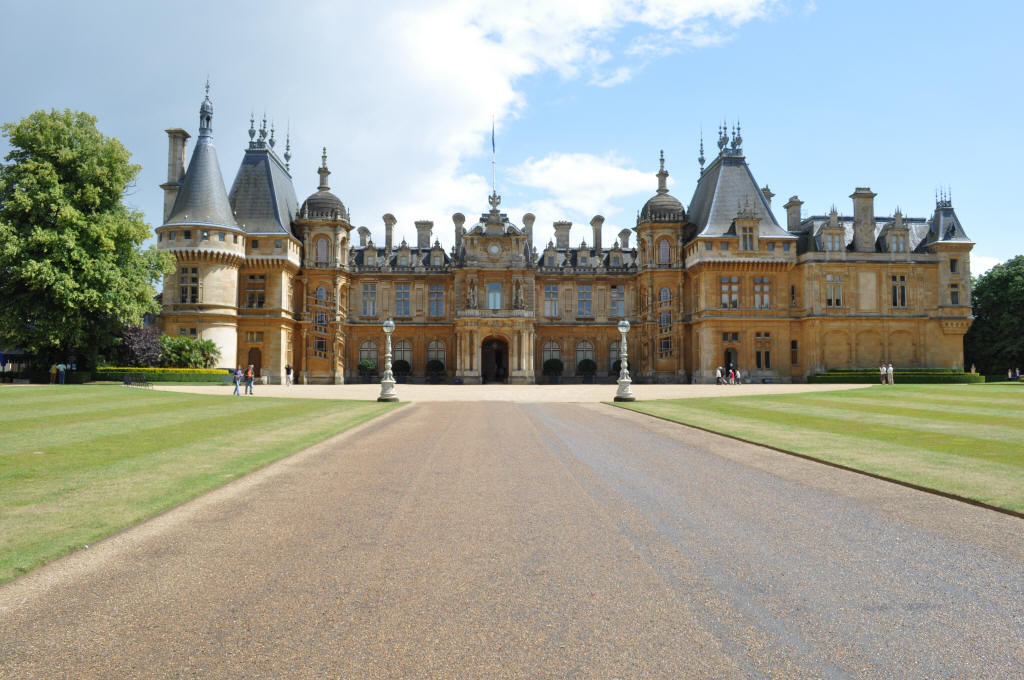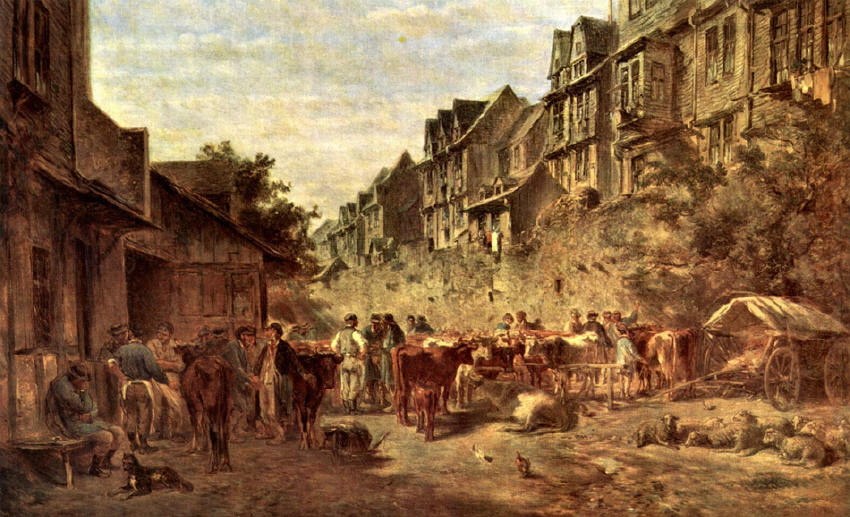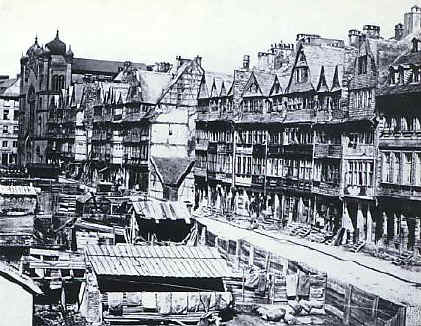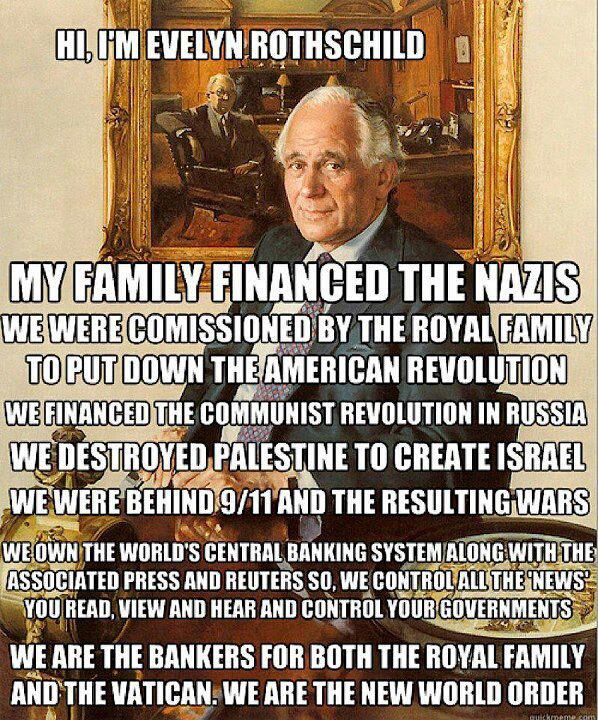Rothschild Track Record - A Jew Boasts
QUOTE
The Jazz Baroness
Hannah Rothschild remembers her distinctly
unconventional great-aunt.
On the night of 15 October, 1958, a
vintage Bentley was pulled over by the Delaware State Police. Suspicions had
been raised by the sight of a white woman driving with two black male
passengers, one of whom had danced his way into a motel along the road in
search of a glass of water. This man was Thelonious Monk and the other man
was Charlie Rouse. Monk refused the officers’ request to leave the car and
they beat his fingers with blackjacks. When the driver screamed that Monk
was a pianist, they beat him harder. Minutes later, the officers found
marijuana in a suitcase which the driver, Nica, claimed was hers. Had Monk
been busted he’d have lost his cabaret card and the right to perform in New
York for up to seven years.
Pannonica de Koenigswarter
[ sic ], or Nica, was a
Rothschild by birth. Born in 1913 at Tring, a Rothschild house in
Hertfordshire, Nica enjoyed a luxurious and cosseted upbringing. According
to her sister Miriam, the internationally renowned naturalist, the only
expectation upon Charles and Rozsika Rothschild’s daughters was to marry and
breed and, although their brother Victor was sent to school and university,
Nica and Miriam received little formal education.
Though music didn’t play a significant
part in her upbringing, Nica claimed her first love was swing and she
preferred bandleaders such as Jack Harris, a violinist who played at ‘coming
out’ parties in the 1930s to traditional debs’ delights. Her unconventional
taste in music was an early indication of a life to come of total
nonconformity. For a time, however, it seemed as if she might settle down;
she married Jules de Koenigswarter, an older, sophisticated, French baron
who lived life to a strict schedule, unlike his wife who had a total
disregard for timekeeping. They lived at a chateau outside Paris where two
of their five children were born.
The Second World War changed everything.
Nica’s brother Victor worked in bomb disposal (he was later awarded the
George Medal) and her sister Miriam was a decoder at Bletchley. Keen to do
her bit, Nica settled her children safely in New York and followed Jules to
Africa to join the Free French working as an ambulance driver. She even made
her way to Berlin and caught the last of the fighting. Like many women, Nica
was emancipated by the war and emboldened by a real sense of achievement.
Settling back into domestic routine was tough and it was even harder to slip
back into the male shadow after years of war-time equality. Robert Kraft, a
musician and friend of Nica’s, points to a similar sense of outrage felt by
the black GIs returning to America from Europe to find that nothing had
changed: they were still expected to use service entrances and, in many
states, obey segregation laws. This discontent was echoed in a new style of
jazz called bebop: music you couldn’t dance or sing to, a music that
heralded a new individualism. It was no coincidence that Nica embraced bebop
wholeheartedly and pursued every opportunity to hear it played live or on
records.
Following the war, Jules was decorated for
bravery and rewarded with a high-status position within the diplomatic
service. The couple was stationed in Norway and then Mexico, but Nica chafed
under the strict formality of life as an ambassador’s wife. Increasingly
mesmerised by the jazz scene, Nica found more excuses to extend their
regular trips to New York until, one day in 1951 she decided to stay. She
told Stanley Crouch, the music critic, that this momentous decision was
inspired by Thelonious Monk’s record Round Midnight, which cast a spell on
her and inspired the start of a new life.
New York in the 1950s was the crucible of
new music, thinking, writing, art and politics. Jazz, the fusion of
indigenous and immigrant rhythms, was now an explosive scene, evolving with
every new arrival: Charlie Parker from Kansas, Monk from North Carolina,
Dizzy Gillespie from South Carolina and Miles Davis from Illinois, who met
and played on 52nd Street and other clubs in the Village.
The life of a musician was cruel: erratic
hours, limited opportunities for work, long spells on the road and the
absence of a welfare system made it hard to support a family, let alone
maintain a home. Many turned to drugs which were available at jazz clubs
where money laundering and drug dealing were rife.
Having witnessed the Second World War,
lost friends and family in the concentration camps and experienced
anti-Semitism first hand, Nica refused to stand by and watch her new friends
suffer because they were black. ‘I don’t see myself as a freedom fighter,’
she told Nat Hentoff in an interview with Esquire, ‘but I do see that a lot
of help is needed.’
In March 1955, Nica was living at the
Stanhope Hotel, a grand establishment on Park Avenue with a policy of
segregation. Late one night, Charlie Parker called by unexpectedly. Parker
was at a low ebb following the sudden death of his daughter and had recently
attempted suicide by drinking iodine. A known drug addict, ‘Parker was lucky
that Nica was prepared to open her door. There was no one left in New York
who’d do that,’ commented Toot Monk. Nica told her version of that night’s
events, how Parker collapsed and died while watching television, to two
people. The first was Clint Eastwood, who told her story in his feature film
Bird. The second was Robert Reisner, who was writing a book, The Legend of
Charlie Parker. In 1950s New York, for a white woman to be alone with a
black man in a hotel suite was cause enough for scandal. For a white, Jewish
Baroness to be alone with the famous black drug addict musician on the night
of his death sent society into an orgy of speculation. ‘Nica paid a high
price for her kindness. After that she was harassed by the press and
police,’ says Toot.
Tabloid newspapers and society gossip did
not succeed in driving Nica back home or halt her numerous acts of kindness.
The Jewish tradition of tzedakah had always been an important Rothschild
principle: she took food and medicine to saxophonist Coleman Hawkins who was
dying of malnutrition and a broken heart; she recovered Sonny Clark’s body
from the morgue and paid for it to be flown home to his family. Perhaps her
greatest gesture to the musicians she knew was to treat them with respect, a
rare experience for African-Americans at that time. ‘She made us feel like
someone just by being with us,’ said Roy Haynes, who was hired by Nica to
play with Monk at a stint at the Five Spot in 1957.
In other cases she acted as manager,
arranging gigs and transporting musicians in her vintage car. ‘I mean, who
wouldn’t get a kick out of going in a Bentley?’ says her friend Phoebe
Jacobs, who remembers seeing the car full of musicians with a double bass
strapped to the roof careering up Park Avenue. Nica fought to scrap the
cabaret card, required by artists to play in licensed clubs but regarded by
many as a police tool to control black musicians. In some cases she provided
money to the very hard up, in others medical or legal assistance and basic
necessities.
But how did this life connect with a
family from a Frankfurt ghetto whose five sons went to five different
capitals of Europe to create five banks that would became powerful enough to
help fund Wellington’s armies, the Gold Rush, the Suez Canal, the arrival of
the railways and the quest for oil? Why had Balfour written to Nica’s uncle
Walter Rothschild, acknowledging that the British Government favoured the
establishment in Palestine of a national home for the Jewish people (later
Israel), and why did Queen Victoria turn down recommendations for Lionel de
Rothschild, the first Jewish MP’s ennoblement with the words, ‘To make a Jew
a peer is a step she could not consent to’? Could Nica’s life have any
connection with all these disparate elements?
Over many years Thelonious and Nellie
Monk, and their children Toot and Boo became part of Nica’s extended
family. To this day, Toot Monk regards Nica’s children as brothers and
sisters. Nica’s photographs, exhibited last summer at Arles and published in
Les Musiciens de jazz et leurs trois vœux ( Jazz Musicians and Their Three
Wishes), edited by her granddaughter Nadine and published in France, capture
the atmosphere of her house in Weehawken. In Nica’s photographs of ping-pong
games and musicians jamming nearly all are laughing. Her daughter Janka and
her grandson Steven lived with her for many years and her other children
Patrick, Berit, Sean and Kari were always close by. ‘The Cathouse’, as Nica
called it, was as far removed from the grandeur and formality of Rothschild
houses as one could imagine. However, like her father, uncle and sister,
Nica liked to be surrounded by animals. The older generation liked exotic
species including cassowaries, emus and wallabies, but Nica preferred cats.
‘I remember one time I counted 305, no, 306 cats,’ says Toot Monk. ‘There
were cats everywhere, cats on the bed, cats on the fridge, cats in the
cupboards.’
When, in the early 1970s, Thelonious
Monk’s mental health deteriorated, Nica offered him a permanent place at her
home. From then until his death, Monk rarely got out of bed, preferring to
view the world through a sea of books, magazines and records spread out
around him. Occasionally he’d play the piano or a game of ping-pong, but
when asked why he refused to perform he replied, ‘I’m just tired of
playing.’ He died in 1982 and at his funeral Nellie and Nica sat side by
side.
Nica was my great-aunt and I had
never met her. In 1984, aged 22, I made my first trip to New York and phoned
her. ‘Would you like to meet up?’ I asked nervously. ‘Wild,’ she answered.
‘Come to the club downtown after midnight.’ This area had yet to be
gentrified and was known for its crack dens, curfews and muggings. ‘How will
I find it?’ I asked. Nica laughed, ‘Look out for the car’ and hung up.
The car was impossible to miss. The
vintage Bentley was badly parked and inside it, two drunks lolled around on
the leather seats. ‘It’s good they’re in there — it means no one will steal
it,’ she explained. Set back from the street was a small door leading down
to a basement. Nica sat at the table nearest the stage. She had long
straight hair and a thin face etched with age and experience. Smoking a
cigarette in a black filter, she dispensed with normal pleasantries and,
picking up a flask from the table, poured something into two chipped china
cups. We toasted each other silently and I drained the cup. Whisky cut into
the back of my throat. My eyes watered. She threw back her head and laughed.
She was seventy-one at the time.
It was the start of an unconventional
friendship with a most exceptional woman. When it was cut short by her
sudden death I took some time to realise that a relationship doesn’t have to
end with death, particularly when a person’s friends are so very keen to
tell her story. My profession is documentary film-making and I have spent my
adult life making portraits of artists, both living and dead, capturing
their spirit and times through interview, archive and their work. Some, like
R. B. Kitaj and Frank Auerbach, were there to be interviewed. Others, like
Picasso, Sickert and Eisenstein had died, but I believe there’s authenticity
and value in any seriously attempted portrait. At the moment I’m shaping 115
hours of footage, including sixty-seven interviews, into a documentary
feature for BBC Arena called The Jazz Baroness, a film of Nica’s
extraordinary life. It is like a kaleidoscope made up of different patterns
of seemingly unconnected parts, which together create an ever-changing
picture. I learned that as a child, Einstein taught her magic tricks, and
she played with gold bars in the vaults of the Bank of England; her beloved
aunt was clubbed to death with meat hooks by SS officers outside Buchenwald;
she lived in Josef von Sternberg’s house with many cats, several children
and one grandchild. Again and again one thing was emphasised: she was a
great patron, part Medici, part Guggenheim operating in the world of jazz.
There’s a scene in the 1988
documentary Straight No Chaser set in the backroom of a New York club where
Thelonious Monk boasts about Nica’s family saying, ‘The Royal Family came to
your family crying the blues and they laid the bread on him to beat Napoleon
— I tell everyone who you are, I’m proud of you — she’s a Rothschild.’
History has a delicious way of evolving: here was a world-class American
musician born in dire straits whose life and career benefited from a fortune
made generations before by an unconnected European family who also suffered
from the obstacles presented by prejudice. Clearly Mayer Amschel Rothschild,
when preparing his five sons to develop their business across Europe, never
imagined that the fruits of their labour would be used to offer protection
and patronage to a generation of brilliant but often destitute jazz
musicians. ‘She was like Joan of Arc and Mother Teresa rolled into one,’
said Monk’s son Toot. ‘She was our light and our joy,’ commented trombonist
Curtis Fuller. Her story lives on in some wonderful jazz standards like
Pannonica by Thelonious Monk, Nica’s Dream by Horace Silver and Art Blakey,
Blues for Nica by Kenny Drew and Tonica by Kenny Dorham. Although legendary
saxophonist Sonny Rollins rarely grants interviews, he made an exception for
my documentary, saying, ‘Nica’s story needs to be told. It’s our story too.’
Hannah Rothschild
is a writer and film-maker.
UNQUOTE
Rothschild has made a film about QUOTE a white British baroness UNQUOTE with
the collusion of the
BBC, a bunch of communist subversives, Jews and
homosexuals. It is part of the
Culture War being waged against us by our
self-appointed
Invisible Enemy. The objective is
Cultural Genocide
Then -
Judengasse circa 1868 - ex Wiki.

Now

Jew Is A Puppet Master [ 15 September 2015 ]
QUOTE
[ The Jew & ]
Financier Nathaniel Rothschild lost a libel case on Friday against a
newspaper that depicted him as a "puppet
master" who used his friendship
with a European trade chief to impress a
Russian oligarch and help close a business deal.
Rothschild sued the Daily Mail over a story that gave a rare insight into
the world of super-rich businessmen who cross continents in private jets,
dine in top restaurants and relax together in saunas........
The article said Rothschild flew the then European Union trade
commissioner
[ & Jew ] Peter Mandelson from the 2005 World
Economic Forum in
Davos,, Switzerland, to Moscow to meet the aluminium billionaire Oleg
Deripaska,
among the richest men in Russia.
UNQUOTE
It is nice to know that a very
rich Jew can fail. See more at
Victory for Daily Mail.
Rothschild Family Suffers From Incestuous Marriages [ 16 November 2021 ]
QUOTE
The Rothschilds, for all intents and purposes, long ago replaced the
British royal family as the de facto rulers of England — and most other
European nations for that matter.
But the Rothschilds and the British royal
families do have this one trait in common — incest and its resultant
nefarious consequences — especially when it is carried out not just a few
times, but rather with each new generation.
Although, since there has always been a far larger “gentile” aristocracy
from which to find appropriate marriage partners, European royals would be
far less inbred than the Jewish Rothschilds, whose marriage options were
comparatively minuscule.
Not that it matters at this point, considering that most British
aristocratic bloodlines have been tainted with Jewish blood for many
generations at this point — selling their sons and daughters off to Jewish
merchants and bankers — exchanging much needed cash infusions to support
their degenerate lifestyles for titles.
But this problem with mental illness is not confined just to
the Rothschilds — Jews, in general,
by their own admission, have much higher levels of mental illness and
genetic diseases caused by breeding in small gene pools.
The incestuous Rothschild dynasty is well represented by the occult
symbol of the snake consuming its own tail — also the symbol of the
Rothschild-sponsored
Illuminati, their
freemasonic recruiting organization.
And there’s no better way to produce much needed psychopaths to carry out
their
anti-Christ nation-wrecking agenda and world domination than through
incest,
pedophilia, and “sex
majick“.
UNQUOTE
Inbreeding can ruin people's genetic heritage
in a few generations. That is why Christianity
forbids marriage between close relatives. It would be
Incest and dangerous. Is this article right? Pass. It hasn't made Rothschild
mob poor yet.
Judengasse on market day, presumably.

Another view of Judengasse from a position nearer to the
synagogue which is on the left.

The cobbles look reasonable here.

Notice the men to the right. They barely show up due to the long exposure times.
Judengasse in 1875

It still hadn't moved up market.
An engraving







